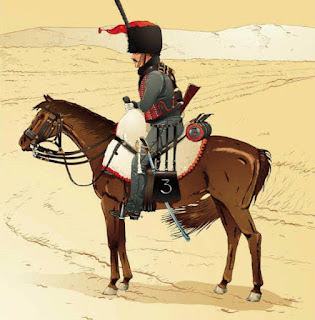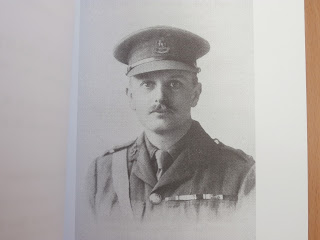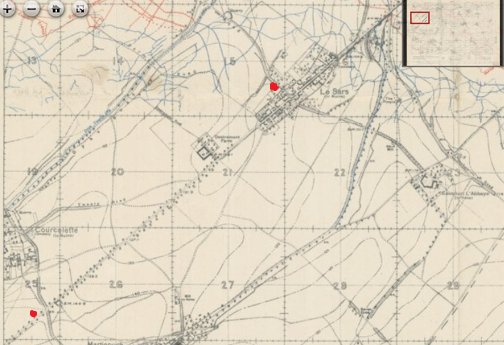(1898 – 9/12/1917)
Edward Cyril Groves was my Great Uncle. My Grandmother Doris was his younger sister.
He was born in 1898 in Lewisham.
1901 Son age 3 [Ernest C].
1911 Son age 13 at school [Cyril].
1913 age 15 he had probably left school and was working and joined the local Territorials [TF].
In August 1913 he was at the 5th London Brigade TF camp in Arundel Park [see group photo] with Reg.
His record says he enlisted in Blackheath and was a resident of Lewisham.
He joined the 20th (County of London) Battalion, The London Regiment (Blackheath and Woolwich) T.F. in March/April 1913 with regimental number No:1223. His older brother Reg was already a member. He would have signed up for 4 years [1913-1917].
Before the war the family lived at 25 Lethbridge Road, Lewisham, SE13.
The HQ of the 20th was at Holly Hedge House just a few streets away.Before the war the family lived at 25 Lethbridge Road, Lewisham, SE13.
20th London Regiment Badge.
In August 1913 he was at the 5th London Brigade TF camp in Arundel Park [see group photo] with Reg.
Arundel training camp. Summer 1913.
1914 after war was declared the Battalion was mobilized and trained locally until early in 1915 when it moved out of London to Surrey and was soon inspected by Lord Kitchener.
Kitchener arrived at 11:00, by which time some of the soldiers had passed out and were taken to the wartime hospital set up at the grandstand on the racecourse. One later died.The purpose of the inspection was to impress the French Minister Millerand but the official party stayed with the troops for only five minutes.
The reason given was the snow, but there may have been another motive.
The 20,000 soldiers on parade only had 100 rifles between them, which were displayed on the front row.
Kitchener knew this and, after walking quickly along the ranks, suggested to his ally that they should call it a day because of the worsening weather.
 |
Lord Kitchener Inspects the 2nd London Division. 22 Jan 1915.
|
 |
| In thick snow on Epson Down |
The reason given was the snow, but there may have been another motive.
The 20,000 soldiers on parade only had 100 rifles between them, which were displayed on the front row.
Kitchener knew this and, after walking quickly along the ranks, suggested to his ally that they should call it a day because of the worsening weather.
Training at Merstham, Surrey Feb 1915. He is on the far right.
24 June 1916 he landed at Le Havre, France, as part of the 2/20th London which was in the 180th Brigade in the 60th [2/2nd London] Division.
60th Division Badge.
180th Brigade patch was a red triangle.
SS La Marguerite.
Reg had only gone to France 9 days earlier [15 June], as one of a draft of reinforcements for 1/20th in the 47th Division. This must have been hard on the family.
5 July 1916 he signed his will as he was going on active service. His name was Edward Cyril but he signed it Earnest Cyril. His medal card also says Edward C.
The 60th Division served in France from June 1916 until Nov 1916, but was not involved in any major fighting (the 2/20th held the ‘P’ trench line in front of Vimy Ridge very close to the current Canadian Memorial park). On 6 July they went into the front line for the first time. By chance the next sector on the left of the 60th Division was held by the 47th Division, the 1/20th being the right hand battalion. Two days later they marched off to the Somme.
Due to the Somme offensive, the Vimy Ridge sector remained relatively quite, but there was plenty of patrolling and trench raiding to be done.

His records indicate he served with them for all that period.
During a rest period out of the line at the hut camp at Mont St Eloi, he may have seen the King. George V made a tour of the front [8 - 15 Aug] and visited Mont St Eloi on the 9th. The battalion informally lined the road when he arrived and had a cricket match afterwards.

The 60th was then transferred to serve in Macedonia from Dec 1916 until June 1917.
They sailed from Marseilles to Salonica by the SS Ivernia 30 Nov 1916.

The 60th Division served in France from June 1916 until Nov 1916, but was not involved in any major fighting (the 2/20th held the ‘P’ trench line in front of Vimy Ridge very close to the current Canadian Memorial park). On 6 July they went into the front line for the first time. By chance the next sector on the left of the 60th Division was held by the 47th Division, the 1/20th being the right hand battalion. Two days later they marched off to the Somme.
Due to the Somme offensive, the Vimy Ridge sector remained relatively quite, but there was plenty of patrolling and trench raiding to be done.

The trenches at Vimy Ridge today.
During a rest period out of the line at the hut camp at Mont St Eloi, he may have seen the King. George V made a tour of the front [8 - 15 Aug] and visited Mont St Eloi on the 9th. The battalion informally lined the road when he arrived and had a cricket match afterwards.
Troops line the road to see the King.
They sailed from Marseilles to Salonica by the SS Ivernia 30 Nov 1916.

The Cunard Liner Ivernia.
She was later torpedoed and sunk by a U Boat, 11 Jan 1917, transporting 2,400 troops to Alexandria.
Camp site of the 2/20th.
Macedonia late 1916.
On their way to the front.
On 1 March 1917 a new TF numbering system was introduced and he was renumbered 630169 [so he was definatly in a theater of war before that as his medal card has both of his numbers on it].
During the time he spent in Macedonia, the battalion was digging miles of trenches and defensive positions to create a reserve line some way back from the front. The greatest enemy at this time was the weather.
10 June 1917. The 60th Division moved to Egypt, arriving at Alexandria 12-18 June 1917. It joined XX Corps in the E.E.F. [Egyptian Expeditionary Force].
But I do not think Cyril went with them. I think he was still ill. His record states he was in Macedonia for an extra 5 months.
During the time he spent in Macedonia, the battalion was digging miles of trenches and defensive positions to create a reserve line some way back from the front. The greatest enemy at this time was the weather.
1-3 March 1917 The Great Blizzard. Terrible weather in Macedonia.
The Great Blizzard. March 1917.
Soon after this he was in hospital.
March 1917. Breakfast in Macedonia.
6 March 1917 he was admitted to No:31 Casualty Clearing Station from 79th Field Ambulance.
Rank of Private in B Company.
Religion C of E.
He was in Ward D2 with a not as yet diagnosed [condition of the feet].
The record says he was age 21 [wrong he was only 19], had been in the army 4 years [probably correct] and been in the field 8 months [about right].
Rank of Private in B Company.
Religion C of E.
He was in Ward D2 with a not as yet diagnosed [condition of the feet].
The record says he was age 21 [wrong he was only 19], had been in the army 4 years [probably correct] and been in the field 8 months [about right].
7 March 1917 he left 31 CCS, and went to a base hospital ?
31 CCS was at Janes, not far from Sarigol in modern day Greece from Aug 1916 to Oct 1918.
31 CCS was at Janes, not far from Sarigol in modern day Greece from Aug 1916 to Oct 1918.
10 June 1917. The 60th Division moved to Egypt, arriving at Alexandria 12-18 June 1917. It joined XX Corps in the E.E.F. [Egyptian Expeditionary Force].
But I do not think Cyril went with them. I think he was still ill. His record states he was in Macedonia for an extra 5 months.
Floriana Hospital – Malta.
From his medal roll
1223 1a [France] 24/6/16 – 29/11/16 agrees with 60th history
1223 2a [Macedonia] 30/11/16 – 17/11/17 5 months extra in Macedonia [28/8/17 Malta]
630169 4b [Egypt] 18/11/17 – 9/12/17 only 3 weeks
By the time he rejoined he had missed all the early battles of the campaign.
Third Battle of Gaza. 27 Oct - 7 Nov 1917.
Capture of Beersheba. 31 Oct 1917.
Capture of the Sheria Position. 6 Nov 1917.
When he arrived in Egypt [18 Nov 1917], the battalion was at Gaza following the Turks how were in full retreat.
They counter attacked 29 Nov to try to retake the key position over looking Jerusalem, the Nebi Samwil Mosque. A, B and C Companies held the Mosque and the summit of the hill, with D Company in support. The Turks bombarded the position all morning and then attacked in force twice during the afternoon. Both times they were driven off with high losses.
The 2/20th had at least 7 men KIA. They were relieved by the 2/22nd the next day for a few days rest.

He was present for the Capture of Jerusalem. 7 - 9 Dec 1917.
Capture of Beersheba. 31 Oct 1917.
Capture of the Sheria Position. 6 Nov 1917.
When he arrived in Egypt [18 Nov 1917], the battalion was at Gaza following the Turks how were in full retreat.
They counter attacked 29 Nov to try to retake the key position over looking Jerusalem, the Nebi Samwil Mosque. A, B and C Companies held the Mosque and the summit of the hill, with D Company in support. The Turks bombarded the position all morning and then attacked in force twice during the afternoon. Both times they were driven off with high losses.
The 2/20th had at least 7 men KIA. They were relieved by the 2/22nd the next day for a few days rest.

Nebi Samwil Mosque before the battle.
He was present for the Capture of Jerusalem. 7 - 9 Dec 1917.
The battle for Jerusalem.
Our oral family history states, that on hearing of his Mother and his Brother’s deaths, he went ‘over the top’ and ‘dun himself in’.
His mother died of cancer in late 1917 and his brother Reg was posted missing on the Somme on 1 Oct 1916 and would have been declared missing, assumed dead about a year later.
His mother died of cancer in late 1917 and his brother Reg was posted missing on the Somme on 1 Oct 1916 and would have been declared missing, assumed dead about a year later.
Possible result of shell shock as well ??
He was killed in action aged 19 on Sunday 9th December 1917.
3 men were killed and 14 wounded in the B Company assault on that day.
CWGC record says. Son of Mr. J. Groves, of 44, Mount St., Charlton, London.
He is buried at the Jerusalem War Cemetery, Israel, in plot R22. The cemetery is 4.5 km north of the walled city at the north end of the Mount of Olives.
With the personal inscription “With deepest sympathy from his loving Father and family.”
With the personal inscription “With deepest sympathy from his loving Father and family.”
He is also remembered on the church memorial at The Ascension Church, Dartmouth Row, Lewisham [as Cyril Groves].
His Service Record Documents.
His medal roll.
His medal index card.
Memorials.
Church memorial.
The personal
inscription at the bottom reads;
“With deepest
sympathy
from his loving Father
and family.”
2014 – his new head stone.
Other Items.
Regimental history in which he is mentioned.
Lt Col William Warde-Aldam DSO.
CO 2/20th London.
Capt Maurice Lane MC MM.
B Company Commander.
Poppies at the Tower of London 2014.
I applied for and had his name added to the Roll of Honour. His and his brother Cyril's names were read out on November 8th 2014, by Miss Diana Lees, Director of the Imperial War Museum. The Last Post was sounded by WO2 [Band Srgt Maj] Ralph Brill, Scots Guards.
To see the video.
They are numbers 52 and 54.
NOTES:
20th London Company locations
HQ, A, B, C and E Coys at Holly Hedge House, Blackheath,
D Coy at New Cross, [2 miles NW]
F and H Coys at Woolwich, [4 miles NE]
G Coy at Catford, [2 miles S] based at St Dunstan’s College
Salonika 1916-17.
The battle of Tumbitza Farm (17 November - 7 December)
The Salonika Force dug-in until the summer of 1916, by which time the international force had been reinforced and joined by Serbian, Russian and Italian units. The Bulgarian attempt at invasion of Greece in July was repulsed near Lake Doiran. At the beginning of Oct 1916, the British in co-operation with her allies on other parts of the front, began operations on the River Struma towards Serres. The campaign was successful with the capture of the Rupell Pass and advances to within a few miles of Serres.
1917
The First Battle of Doiran (22 April - 8 May)
The Capture of Ferdie and Essex Trenches (near Bairakli Jum'a) (15 May)
The Capture of Bairakli and Kumli (16 May)
During 1917 there was comparatively little activity on the British part of the front in Macedonia, due in part to complex political changes in Greece throughout the year. The main fighting took place around Lake Doiran, where the line was adjusted several times by each side early in the year. In April 1917, the British attacked, gained a considerable amount of ground and resisted strong counter-attacks. In May, the Bulgarians attacked the British positions, but were firmly repulsed. The British action in May triggered a series of attacks elsewhere on the front by the other Allies, known as the Battle of Vardar.











































